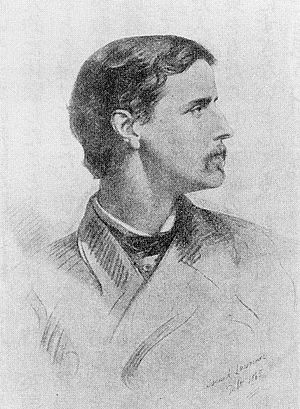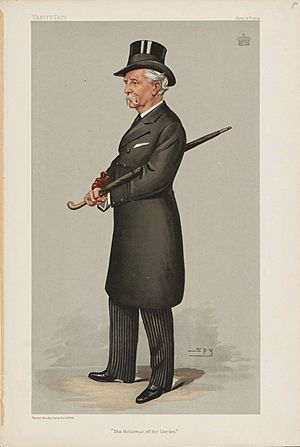Algernon Mitford, 1st Baron Redesdale facts for kids
Quick facts for kids
The Lord Redesdale
|
|
|---|---|
 |
|
| Member of Parliament for Stratford-on-Avon |
|
| In office 4 July 1892 – 8 July 1895 |
|
| Preceded by | Frederick Townsend |
| Succeeded by | Victor Milward |
| Personal details | |
| Born |
Algernon Bertram Mitford
24 February 1837 London, England |
| Died | 17 August 1916 (aged 79) Shipston-on-Stour, Gloucestershire, England |
| Political party | Conservative |
| Spouse |
Lady Clementina Ogilvy
(m. 1874) |
| Children | 9, including David |
| Education | Eton College |
| Alma mater | Christ Church, Oxford |
Algernon Bertram Mitford, 1st Baron Redesdale, GCVO, KCB, DL (born 24 February 1837 – died 17 August 1916) was an important British diplomat, traveler, collector, and writer. He often wrote under the name A.B. Mitford.
Mitford was especially interested in Japan and traveled widely in East Asia during the Meiji-period. His most famous book is Tales of Old Japan (1871). This book helped many people in the Western world learn about classic Japanese stories. Other books he wrote include The Bamboo Garden (1896) and Memories (1915). In 1886, he added "Freeman" to his last name because of an inheritance. He was also the grandfather of the famous Mitford sisters.
Contents
Early Life and Family
Algernon Mitford was born in London on 24 February 1837. His father was Henry Reveley Mitford. Algernon went to Eton College, a famous school, and then studied at Christ Church, Oxford University. His family had a long history, owning places like Mitford Castle in Northumberland. His mother, Georgiana Jemima Ashburnham, came from a noble family connected to the Duke of Northumberland. When Algernon was only three years old, his parents separated.
He was sometimes called "Barty" or "Berty" by his family and friends.
His Career and Adventures
Working as a Diplomat
In 1858, Mitford started working for the Foreign Office, which handles Britain's relationships with other countries. His first job was at the British Embassy in St Petersburg, Russia. Later, he worked in Shanghai, China.
His most exciting diplomatic role was in Japan. He went there as a second secretary during the Meiji Restoration. This was a time when the Emperor's rule was brought back, and Japan's capital moved from Kyoto to Edo (which is now Tokyo). Mitford's writings tell about the challenges faced by foreign communities in Japan during this period.
While in Japan, he met Ernest Mason Satow, another British diplomat. Together, they traveled a lot across Japan. Mitford also became friends with Saigō Takamori, a famous samurai warrior. Mitford left the diplomatic service in 1873.
Tales of Old Japan
Mitford's book, Tales of Old Japan (1871), is very important. It was the first time many Western readers learned about classic Japanese stories like "The Forty-seven Ronin". This book helped bridge the gap between Japanese and Western cultures.
Public Life and Other Roles
After his diplomatic career, Mitford took on other important roles. From 1874 to 1886, he worked as a secretary for HM Office of Works. In this job, he helped with the long restoration of the Tower of London and worked on designing parts of Hyde Park.
He also became a Member of Parliament for Stratford-on-Avon from 1892 to 1895.
The Mikado Connection
Interestingly, Mitford helped the famous writers W. S. Gilbert and Arthur Sullivan when they were creating their opera The Mikado in 1885. He gave them advice on Japanese culture. A traditional Japanese song that Mitford hummed to them was even used in the opera for the Mikado's entrance music!
Later Life and Interests
In 1886, Mitford inherited large country estates and added "Freeman" to his name. He became a magistrate, which is a type of judge, and also started farming and breeding horses. He was also a member of the Royal Yacht Squadron, a famous yacht club. From 1910 to 1912, he was the President of the Royal Photographic Society.
He rebuilt Batsford House in Gloucestershire, but it was very expensive. The house later had to be sold.
Love for Gardens and Plants
During his time in the Far East, Mitford became very interested in Chinese and Japanese gardens and plants. When he returned to England, he created the Batsford Arboretum at his home. This was a special garden designed to look natural, inspired by what he saw in China and Japan.
His 1896 book, The Bamboo Garden, was the first book about growing bamboos in cooler European climates. He even convinced Edward VII, the King, to plant Japanese knotweed at Sandringham House. However, this plant later became very difficult to remove!
Marriage and Family
In 1874, Algernon Mitford married Lady Clementina Gertrude Helen Ogilvy. They had nine children together: five sons and four daughters. Their son, David Freeman-Mitford, later became the 2nd Baron Redesdale. David was the father of the famous Mitford sisters, a group of six sisters known for their different lives and strong personalities.
Becoming a Peer
In 1902, Algernon Mitford was given a special honor. He was made a Baron Redesdale, a title that allowed him to sit in the House of Lords, which is part of the British Parliament. This title was given to him on 15 July 1902.
See Also
- Hugh Cortazzi, Mitford's Japan : Memories and Recollections, 1866–1906, Format: Paperback, Published: January 2003, ISBN: 1-903350-07-7
- Meiji Restoration
- Anglo-Japanese relations
- Mitford family
- Baron Redesdale


